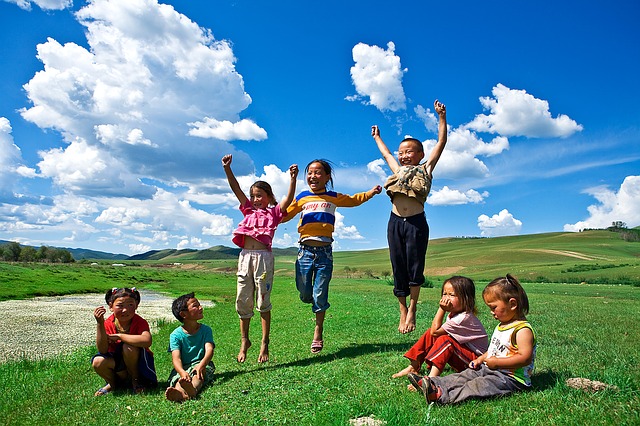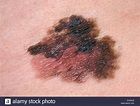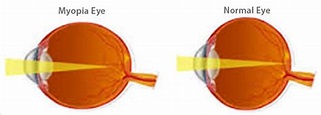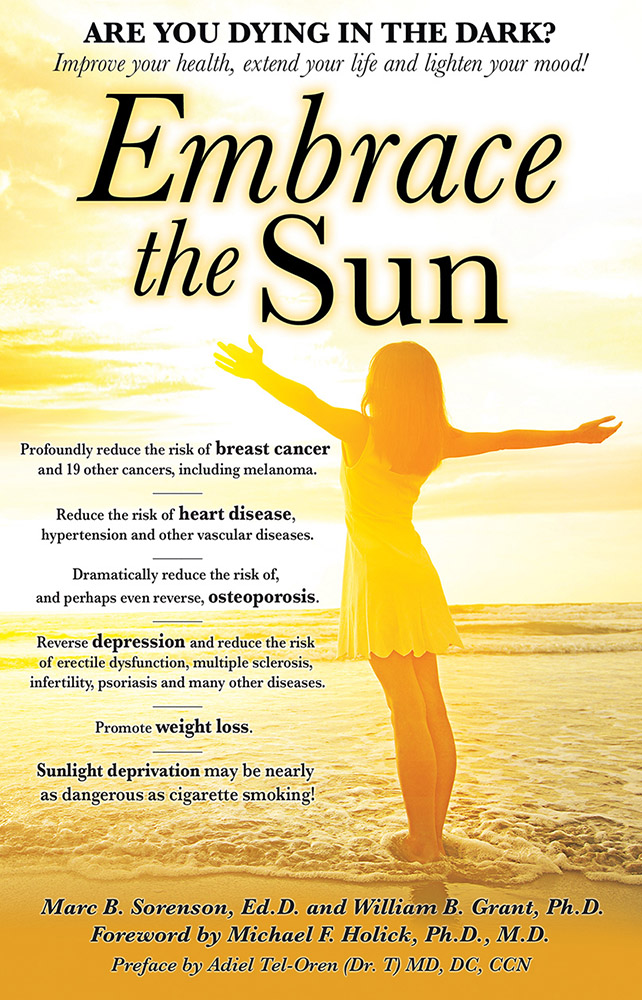Saving the children by Marc Sorenson, EdD.

Saving the children is a multi-part discussion that emphasizes the critical need for sun exposure in children because of sun deprivation. In the last blog on the subject, we first of all talked about saving the children from myopia (nearsightedness). And this blog will discuss several additional aspects of childhood health that are positively related to sunlight.
Why are we depriving our children of sunlight? Because $ are involved. So, we must not fail to be about the business of saving the children from the Powers of Darkness.
Saving the children from melanoma. With sunlight!

First of all, much noise is made about removing children from sun exposure to protect them from future melanoma. Consequently, we “protect” them from sunlight by keeping them indoors and dutifully slathering them with sunscreen. Furthermore, our children are taught to fear the sun. That is strange, since research shows that children who engage in outdoor activities are less likely to develop melanoma. In that research, outdoor exercise such as soccer and gardening were mentioned as the most noteworthy activities to protect against melanoma.
Saving the children from asthma. With sunlight!
Asthma, an inflammation of the air passages, has become a scourge of both children and adults. And according to the Asthma and Allergy Foundation, each day 40,000 people miss school or work due to asthma. In addition, 30,000 people have an attack daily, and 5,000 people visit the emergency room.[1] Especially relevant is the fact that the disease is increasing most rapidly among black children. Dark skins need more sunshine to produce vitamin D, which may make these children more susceptible. So what does the research say about sunshine and asthma in children? The most important study was probably one from Spain. It showed that children exposed to the most sunlight had much lower risks of asthma than those who were least-exposed. Thus, each with each hour of added sun exposure per day predicted a decreased risk of the disease.[2]
Saving the children from HIV infection (AIDS)
AIDS is a fearful disease, and it is most noteworthy that the children, the most vulnerable among us are victims. Saving the children from AIDS should be a priority, no?
Sunlight exposure leads to the production of vitamin D, and vitamin D may have a profound influence on the development of AIDS. Thus, HIV-positive pregnant women with lowest vitamin D levels had 50% greater risk of transmission of HIV to their children. Also, there was a two-fold increase of HIV transmission by breast feeding. In addition, there was also a 61% increased death risk among children born to women with low Vitamin D levels.[3] Therefore, sunlight is key to saving the children from this horrible disease.
In conclusion, melanoma, asthma and
AIDS are diseases our children should never need to suffer. Furthermore, regular,
non-burning sun exposure should be a part of the daily lives of children
whenever possible.
Learn more my visiting http://sunlightinstitute.org/ And read
the new book, Embrace
the Sun.
[1] Asthma and Allergy Foundation of America: Asthma Facts and Figures. http://www.aafa.org/display.cfm?id=8&sub=42
[2] Arnedo-Pena A, et al. Sunny hours and variations in the prevalence of asthma in schoolchildren according to the International Study of Asthma and Allergies (ISAAC) Phase III in Spain. Int J Biometeorol 2011;55:423-434.
[3] Mehta S, Hunter DJ, Mugusi FM, Spiegelman D, Manji KP, Giovannucci EL, Hertzmark E, Msamanga GI, Fawzi WW: Perinatal Outcomes, Including Mother-to-Child Transmission of HIV, and Child Mortality and Their Association with Maternal Vitamin D Status in Tanzania. J Infect Dis 2009;200:1022-30.
Save the children with sunlight. by Marc Sorenson, EdD

Save the children is a refrain heard throughout the world, and a great refrain it is. It truly is time to save the children. There is so much child abuse and so many childhood health disasters that it is a burden we cannot ignore. It is especially relevant that our children are addicted to noxious foods and sedentary lives. And, the sun robbery they experience is equally harmful. This article is the first of several discussing the necessity for sun exposure if we are to save the children.
Save the children from myopia.
First of all, myopia (nearsightedness) among children is pandemic and increasing at an alarming rate. And, researchers demonstrated as early as 2008 that the lowest myopia risk was among those with highest outdoor activity. Some have surmised that the key ingredient that could save the children from myopia was exercise. But, the researchers refuted that idea because they also demonstrated that indoor exercise did not reduce myopia risk.

Most noteworthy, the same research showed the prevalence of myopia among Chinese children living in Singapore was 29.1%. Furthermore, the prevalence among Chinese children living in Sydney, Australia was only 3.3%. Is this because the Sydney children spent about 13.8 hours per week outdoors compared to 3.1 hours in Singapore? Hence, the children who spent most of their lives indoors had 9.5 times the risk of developing myopia! So adults in Sidney who let their kids play in the sun, certainly knew how to save them from myopia.
How much sunshine does it take?

Children under six should spend three hours daily in sunshine, according to other researchers who want to save them. So what could be a more natural? Just be sure the children do not burn.
Consequently, the next time someone tells you that it is not good for children to play outside, tell them the facts. Outdoor activity in the sunlight is absolutely necessary to save them from myopia. For more information: sunlightinstitute.org, and read my book, Embrace the Sun.

By Marc Sorenson, EdD, for sun exposure and children’s health…
It is well-known that sun exposure is associated with a reduced risk of many major cancers in adults. But what about children? A California study has shown that sun exposure during pregnancies also influences the childhood cancer risk of children who are a result of those pregnancies.[1] In this research, sun exposure, based on the geographical area where the women lived while pregnant, was measured. Then their children were compared in terms of childhood cancer risk, based on high or low sun exposure. Those children whose mothers experienced more sun exposure were less likely to develop acute lymphoblastic leukemia, hepatoblastoma, and non-hodgkin’s lymphoma. The authors of the study make this summary statement: “Our findings suggest that UVR during pregnancy may decrease the odds of some childhood cancers. Future studies should explore additional factors that may be correlated with UVR exposure and possibly include biomarkers of immune function and vitamin D.”
We have discussed in previous blogs the association of sunlight deficiency during women’s pregnancies and the subsequent risk of profoundly increased autism in their children. Therefore, similar results with cancer are not surprising. Safe, non-burning sun exposure has positive effects on at least 100 of the most frightening diseases, many of which will be discussed in my upcoming book that is coauthored by Dr. William B. Grant, and entitled Embrace the Sun. Children, even babies, need at least some sun exposure. And children, if they do not get outdoors in the sun are also subject to a remarkable increase in the risk of myopia.[2]
Take care of your children. Be sure that they play in the sunlight each day, without sunscreen. If any reddening occurs, put them in the shade or cover them up. But don’t deny them their share of sunshine; if you do, their risk of childhood cancers may increase.
[1] Lombardi C, Heck JE, Cockburn M, Ritz B. Solar UV radiation and cancer in young children. Cancer Epidemiol Biomarkers Prev. 2013 Jun;22(6):1118-28.
[2] Rose KA, Morgan IG, J, Kifley A, Huynh S, Smith W, Mitchell P. Outdoor activity reduces the prevalence of myopia in children. Ophthalmology 2008 Aug;115(8):1279-85.
By Marc Sorenson, EdD. For sun exposure…
It should be well-known by now, but the relationship between sun exposure and myopia (nearsightedness) is still being studied. And as before, the answer is the same: sun deprivation is associated to a greater myopia risk. The difference in this research was the study population, which was a random sample of participants 65 years and older from Europe.[1] Among the factors that the researchers considered important, were vitamin D blood levels, vitamin D polymorphisms, ultraviolet B radiation (UVB), and years in education. Of these factors, only ultraviolet B radiation (UVB) was associated with reduced odds for myopia, especially if higher UVB exposure occurred during adolescence and early adulthood. This is another research paper that shows sun exposure to be protective against a disease, independent of vitamin D.
The authors of the study made this conclusion: “This study, while not designed to determine cause and effect relationships, suggests that increased ultraviolet B exposure, a marker of sunlight exposure, is associated with reduced myopia.
This is one in a long line of studies that show the relationship of sun exposure to myopia, and it doesn’t take a rocket scientist to determine that myopia is caused by lack of sun exposure. The evidence has been building for years. For example, one of the studies showed that the lowest risk of myopia among 12-year-old students was found among those who reported the highest levels of outdoor activity.[2] Some might surmise that the key ingredient was exercise, but that idea was refuted by the fact that there was no association between indoor activity and myopia. Something besides exercise had to be leading to the lower risk of myopia among children who were actively outdoors; it had to be sun. The lower risk of myopia persisted after adjusting for genetic factors, ethnicity and the amount of near work. This is important, because for many years there was an assumption that long hours of study indoors, staring closely at books (near work) and never focusing on distant objects, led to myopia. This study belied that error.
This same research showed that the prevalence of myopia among Chinese children living in Singapore was 29.1%, whereas Chinese children living in Sydney, Australia, had a prevalence rate of only 3.3%. The children in Sydney spent about 13.8 hours per week outdoors compared to 3.05 hours in Singapore. In other words, the children who spent most or their lives indoors had 9.5 times the risk of developing myopia!
Depriving either adults or children of their time in the sunlight leads to myriad illnesses, only one of which is myopia. When will we learn?
[1] Katie M. Williams, FRCOphth; Graham C. G. Bentham, MA; Ian S. Young, MD; et al Association Between Myopia, Ultraviolet B Radiation Exposure, Serum Vitamin D Concentrations, and Genetic Polymorphisms in Vitamin D Metabolic Pathways in a Multicountry European Study. Published Online: December 1, 2016. doi:10.1001/jamaophthalmol.2016.4752
[2] Rose KA, Morgan IG, J, Kifley A, Huynh S, Smith W, Mitchell P. Outdoor activity reduces the prevalence of myopia in children. Ophthalmology 2008 Aug;115(8):1279-85.
By Marc Sorenson, EdD, Sunlight Institute…
Several scientific investigations have linked sunlight deprivation to nearsightedness (myopia), and many of these have been discussed on previous blogs. The latest used rhesus monkeys as subjects.[i] These monkeys were reared either with natural lighting for three hours daily or indoor lighting. As we might expect, those that were raised with indoor lighting developed myopia, whereas those raised with natural lighting did not develop the disorder. The eye dimensions became abnormal in the monkeys that were exposed only to indoor light, and problems with refraction, due to eye elongation, were noted.
There is no doubt that sun deprivation is a factor that leads to blindness. Others obviously feel the same way. Here I quote from Dr. Hobday, writing in Perspectives of Public Health: “A century ago, it was widely believed that high levels of daylight in classrooms could prevent myopia, and as such, education departments built schools with large windows to try to stop children from becoming short-sighted. This practice continued until the 1960s, from which time myopia was believed to be an inherited condition. In the years that followed, less emphasis was placed on preventing myopia. It has since become more common, reaching epidemic levels in East Asia. Recent research strongly suggests that the amount of light children get as they grow determines whether they will develop short sight; however, evidence that daylight in classrooms prevents myopia is lacking. Given the rapid increase in prevalence among school children worldwide, this should be investigated.”[ii]
Others are also concerned and state that eye elongation and progression of myopia decrease in periods with longer days and to increase in periods with shorter days.[iii] According to these researchers, “children should be encouraged to spend more time outside during daytime to prevent myopia.”
[i] Wang Y, Ding H, Stell WK, Liu L, Li S, Liu H, Zhong X. Exposure to sunlight reduces the risk of myopia in rhesus monkeys. PLoS One. 2015 Jun 1;10(6).
[ii] Hobday R. Myopia and daylight in schools: a neglected aspect of public health? Perspect Public Health 2015 Mar 23.
[iii] Cui D, Trier K, Munk Ribel-Madsen S. Effect of day length on eye growth, myopia progression, and change of corneal power in myopic children. Ophthalmology. 2013 May; 120(5):1074-9
You may not realize that sunlight is critical for good vision in children, but in my opinion, the science provides incontrovertible evidence. A new study has corroborated the findings of a number of earlier investigations.
The Daily Mail, a UK newspaper, reported that “Too much time indoors damages children’s eyes: Lack of natural sunlight thought to be driving up rates of short-sightedness among the young.[i]” They also mention that Chinese children are now being sent to schools with translucent walls to prevent the nearsightedness associated with lack of sunlight.
By: Marc Sorenson, Sunlight Institute–
Among the many other horrors associated with lack of sunlight, myopia (nearsightedness) is now becoming of scientific interest. In the latest article written on the subject, Robin Wuffson, MD, discusses the research from Denmark, showing that deterioration of the eye leading to myopia (in children aged 8-14) is more common in the winter than in the summer months.[1]
Another piece of research, reported only a few months ago, showed that actual exposure of the eye to sunlight was protective against myopia in people aged 15 to 50 years.[2] If you search this site, you will find several other posts on sunlight and myopia. In my opinion the link is now irrefutable: Lack of sunlight can now be added to the list of environmental and nutritional mistakes that can lead to blindness.
“Do not take my Sunshine Away!”
[1] http://www.emaxhealth.com/11306/sunlight-exposure-reported-decrease-vision-deterioration-children
[2] Sherwin JC, Hewitt AW, Coroneo MT, Kearns LS, Griffiths LR, Mackey DA. The association between time outdoors and myopia. Invest Ophthalmol Vis Sci. 2012 Jul 1;53(8):4363-70.
Another in a line of studies on sunlight and myopia (near-sightedness) demonstrates that people who spend more time is the sun are less likely to have this pandemic vision problem. Other research on the relationship of sunlight exposure and myopia, some of it reported in my book, primarily considered the risk of myopia in children. This new investigation, however, surveyed young adults, and found that those who had the lowest exposure to sunlight were twice as likely to contract myopia.
Myopia is not an insignificant problem; when severe, it may lead to blindness. Obviously, we need to make sure that our eyes receive some sunlight regularly to help prevent this widespread disorder.
Evidence continues to accumulate that sunlight is necessary to normal growth and development of children’s eyes; without sunlight, myopia (nearsightedness) develops. It should be a priority for each family to assure that children leave their computers and video games behind for a few hours daily and play like normal children should–in the sunlight.


